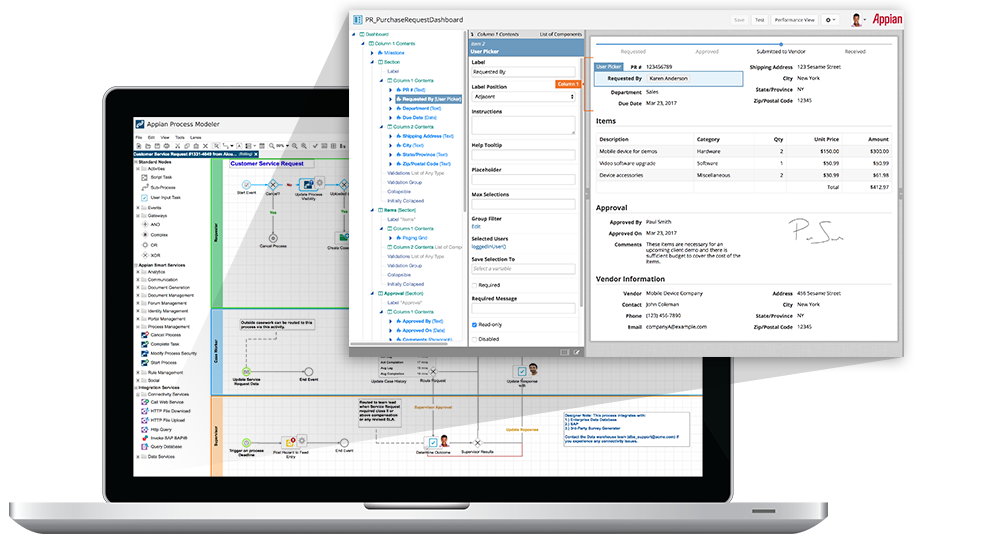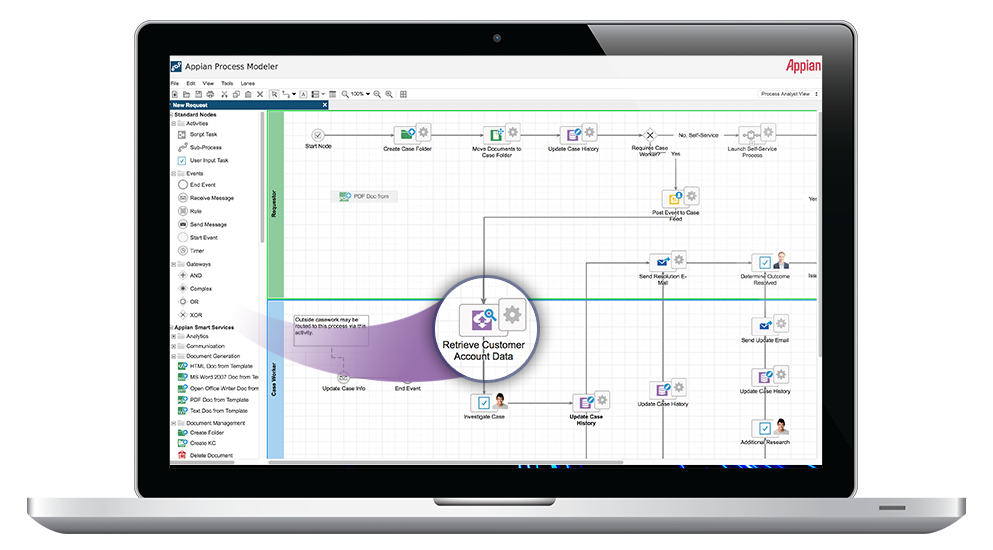Appian’s Low-Code Platform Adds Intelligence, Automatic CPU Parallelization; Sets Low-Code Goals for 2018
Appian is enhancing its low-code / no-code app platform with more intelligence, automation and higher performance – all to extend the reach of what’s possible with low-code. IDN talks with Appian’s vice president Malcolm Ross about the latest upgrades – and the future of low-code in 2018.
by Vance McCarthy
Tags: Appian, BPM, case management, integration, low-code, parallel processing, RPA,

vice president, product

"Appian believes low-code platforms are the future of software development. That means they [need] capabilities on par to 3GL coding, but in a way that is simple, intuitive and intelligent."
 Modern Application Development for Digital Business Success
Modern Application Development for Digital Business SuccessAppian is enhancing its low-code / no-code app platform with more intelligence, automation and higher performance – all aimed at extending the reach of what users can build without programming.
In specific, Appian is adding more intelligent and automatic CPU parallelization for multi-core processing. Parallel computing opens the door to new functionality and high-performance, thanks to its capacity to support computations that require multiple simultaneous calculations, Appian’s vice president for product Malcom Ross told IDN.
“Appian ultimately believes low-code platforms are the future of software development. That means low-code platforms must have capabilities on par to 3GL coding, but implement them in a way that is simple, intuitive and intelligent,” Ross said.
Notably, Appian’s platform delivers these seamlessly and automatically, allowing non-developers to design and implement more complex rule and interface logic, Ross added.
Appian’s Low Code Recipe: Intuitive UI, Smart Agents, Integration & Parallelism
Appian’s recipe infuses it’s low-code platform, with a mix of technologies that support the entire app lifecycle -- from low-code design, automatic build, integration with outside data and services and tuned for high-performance, Ross told IDN. The result is a cloud-based Application as a Service architecture. The Appian’s platform includes an intuitive drag-and-drop UI, along with low-code integration, intelligent agents and CPU parallelization.
This combination enables non-technical users to create a whole new class of sophisticated, highly performant app, he added.
Ross shared one example. “Custom coding is often required for apps to support parallel computing, Furthermore, as the number of CPU cores increase over time, now as high as 32 or more, writing code that takes maximum advantage of these cores becomes increasingly challenging,” Ross told IDN, adding “3GL coding for parallel computing is hard because it forces the developer to analyze the dependencies of individual I/O calls, avoid race conditions, and avoid potential bugs associated with parallel processing.”
So, to avoid these problems and snafus, the latest update to Appian’s platform takes the coding out of the mix. Not only does Appian’s approach avoid many of the complexities 3GL developers face, it actually opens parallel processing capabilities to non-technical users who don’t know how to code at all, Ross said.
Under the covers, the Appian platform intelligently analyzes the software designed in the UI – and then automatically generates the code and optimize it for parallelization across multiple CPU cores, he added.
Ross also named some of the multiple benefits parallelization can being to apps. “Parallel processing allows software code / algorithms to make optimum use of multi-core CPUs to reduce the time it takes to compute a customer's application logic. This results in a faster response time for end-users,” Ross noted. “In situations where parallel processing can boost performance, such as invoking several I/O operations simultaneously, customer applications are now significantly faster and more responsive.”
In fact, in preliminary tests, Appian has demonstrated performance has increased by as much as 300% in applications with multiple I/O operations, he added.
Parallel computing is crucial to modern apps relying on an architecture that brings together multiple and disparate services (including data, objects and microservices) - rather than building a standalone app. Parallel processing is important for even those apps, allowing microservices to be called in parallel and ultimately reducing computation time, Ross noted.
“As apps increasingly become a composite or orchestration of microservices, it is important for developers to invoke this in parallel so as not to create long delays in computing and response times,” he said. While our low-code platform can be used to support demanding and complex business applications, even simpler applications [can benefit] from parallel processing – as [all apps] are increasingly being built by composing several microservices… Parallel processing allows microservices to be called in parallel and ultimately reducing computation time.”
The latest parallel computing support was designed to work with auto-integration features Appian added to its platform earlier in 2017.
Appian’s Integration Designer enables users to connect their low-code / no-code apps to multiple outside services with only a simple configuration set-up. Once the integration is established, these services may be invoked in parallel for ideal performance, Ross noted. Appian’s out-of-the-box support for low-code integration includes ways to connect with top enterprise apps (including SAP, Oracle Siebel, Microsoft Dynamics, etc.). For custom apps and services, Appian also sports connections for diverse API-driven integration with SOAP and REST service endpoints, he added.
Appian’s latest update also sports other feature to simply design and speed up deployment, Ross added. Among them:

- Improved charting in reports and linking controls
- Fast export to Microsoft Excel from Appian Reports
- Support for the latest iPhone 8 / 8 Plus and iPhone X running iOS 11 and Android 8 mobile devices
- Simplified integration design for connecting to common systems
- Accelerated interface design for building rich user experiences
Forrester Finds Low-Code Gaining Enterprise Acceptance
The release of the latest edition of the Appian platform comes as a recent survey of enterprise IT professionals by Forrester found acceptance of low-code platforms growing as benefits become more evident.
The survey of application development and delivery professionals found a majority reported that low-code approaches are helping them more quickly and effectively design and launch apps for improved customer experience, process efficiency and business agility.
According to survey results, low-code platforms are delivering significant improvement over traditional development practices in a number of areas. Among them:
- speed to deliver process innovation/improvements
- faster app updates
- meeting business requirements on time
Further, respondents said a low-code platform could help them address many challenges in the chase to meet today’s escalating demand for digital change:
- Contain / reduce high cost of app development and updates (39 percent)
- Comply with business requirements (33 percent) and
- Keep up with business demands for new functionality (21 percent)
“Every day, there’s more and more evidence that all sorts of companies love the idea of agile. They want fast iterations, an easy feedback loop between developers, business and IT – but not every company has the skills to accomplish agile with traditional development,” Appian CEO Matt Calkins told IDN. “At Appian, we’re helping make agile happen with a low-code approach. We’re bringing a lot of attention to details, so our customers don’t have to be expert developers.”
Under the covers, Appian’s attention to details of the full app lifecycle include many features to help deliver agile and impactful apps, Calkins added. Aside from those already mentioned, Appian’s platform also sports Among them:

- Extensible platform to easily add new / emerging tech (AI, Machine Learning, etc.)
- Foundational data layer (called Records), which converges business information – typically trapped across legacy systems and individual apps
- Dynamic case management for seamless customer experience
- Enterprise-caliber security, availability, and scalability
- Robotic Process Automation to automate routine tasks across legacy and modern systems
- CEP (complex event processing) to combine and correlate events from multiple systems for automated, smart workflow apps
- Data parsing and transformation to automate sharing of diverse data across apps and systems
- Customize extensibility via OSGi framework-compliant plug-ins
This list of services reflects the vision Appian intends to pursue in 2018 for expanding the reach of low-code – not only for building ‘new, greenfield apps,’ but to also extend aging legacy apps.
“Today, a typical organization can have at least 1,000 unique apps already – without counting the dozens of new ones in the pipeline,” he told IDN. “So, our approach to low-code brings automation and simplicity to all types of applications, new and existing. Appian’s low-code platform provides auto-scaling, easy steps to change and update apps, and the ability to run their apps on multiple platforms, including ones that haven’t been invented yet.”
Given this type of expansion to the low-code approach, Forrester predicts the low-code platforms market will reach over $10B in revenue by 2019.
Related:
- InfluxData's Latest Updates Optimize Time Series Data for Better Performance, Scale and Management
- Actian Zen 16.0 Update Simplifies Delivery and Boosts Performance of Edge, IoT Apps
- Virtana Infrastructure Performance Management Adds AI-driven Capacity Planning
- e2open’s Supply Chain SaaS Updates Help Firms Reduce Operational Risks with Deeper Visibility
- Report: Endor Labs Identifies 2023 Operational, Security Risks To Open Source
All rights reserved © 2025 Enterprise Integration News, Inc.


